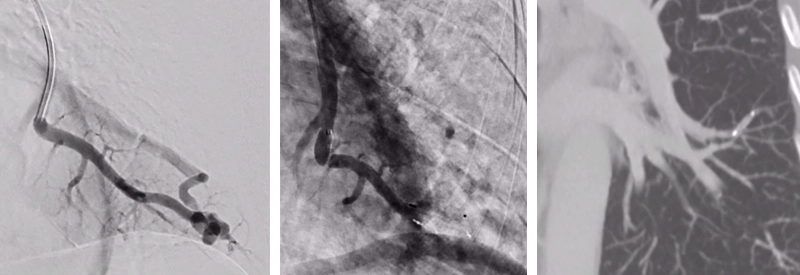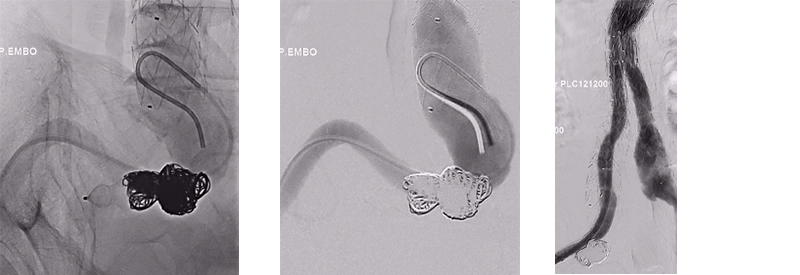Plugs and coils are very important tools in interventional radiology. Whenever you want to occlude something, plugs and/or coils might be used. The classical application of those devices is any kind of vessel sacrifice (e.g. endoleak treatment, arterial bleeding, preventive embolization before surgery, etc.) or any kind of aneurysm (cerebral or peripheral). Various smaller and some larger studies deal with the question if coils or plugs are the preferable choice. However, in reality the IR has to decide from case to case what device is the better choice, also depending on the local situation, availability of the respective tools, own experience, and costs.
Vascular plugs
The most common plugs on the market are the Amplatz vascular plugs and more recent the microvascular plugs. The Amplatz plugs are available in different types (Amplatz vascular plug, Amplatz vascular plug II and IV) that are different in size and length and are available in diameters up to 22mm. The plugs are delivered via a macrocatheter for the smaller plugs and via guiding catheters or sheaths for the larger plugs. The sizing of the plug depends on the indication and placement location but the oversizing might be up to 50%. The plugs are made of an nitinol mesh and in most cases there is not an instant occlusion achievable since it needs some time to get enough clotting for a complete vessel occlusion. This does not matter in indications like vessel sacrifice for example before stentgraft placement, but definitively might be a problem in bleeding indications. The microvascular plugs are available in 4 different sizes between 3 and 9mm and have a treatment range between 1.5mm and 9mm. The microvascular plugs are delivered via micro- or macrocatheters and consist of a self-expandable nitinol network covered with a membrane. These plugs achieve instant vessel occlusion and have only minor artefacts in following CT controls (in contrary to coils and larger vascular plugs).
Coils:
The market of coils is a very huge one and many different coils from multiple vendors are available. In general the following classes of coils are available:
- Macrocoils delivered via macrocatheters, these coils might be pushable or detachable
- High volume detachable microcoils – these coils are thicker than normal microcoils with a consecutive large volume but can be delivered via a 0.025’’ microcatheter.
- Detachable microcoils (with or without fibers)
- Pushable microcoils (with or without fibers)
Fibered versus unfibered coils
The coils might have fibres or not, one vendor provide coils with a hydrogel coating – different studies deal with the question if the use of fibered/coated coils lead to a quicker and more durable vessel/aneurysm occlusion, nevertheless no clear data is available about that question.
Pushable versus detachable coils
In general pushable coils are cheaper than detachable coils. Nevertheless detachable coils are in longer lengths available (up to 60cm). If more coils are used in an embolization procedure detachable coils might end with the same or cheaper procedure price since a smaller number of coils is necessary for a successful embolization.
There are different mechanical or electrical detachment mechanisms available and most of the detachable coils have dedicated detachment handles in order to place the coil. The use of detachable coils is safer than the use of pushable coils. Detachable coils always can be pulled back if they do not go in the right direction or are pushed back out of the aneurysm etc.
Packing density
One important topic for all kind of coils is the packing density – the more coils are packed in a vessel/aneurysm, the higher is the packing density. With a higher packing density less compaction and recanalization of coils is achieved, this might be important especially in aneurysms – the packing density in order to achieve a durable occlusion in aneurysms should be 24% or more.
In summary, every IR should be familiar with the available plugs and coils on the market and in every IR institution a selection of plugs and coils should be available in order to be ready for all different kind of embolization procedures like bleedings or aneurysms or even any kind of vessel sacrifice.




